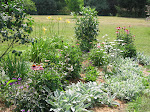 Even though there is a chance of snow tomorrow, it has been looking and feeling like spring for the past several days. Daffodils are blooming, and the daylilies and iris are really growing. The rhubarb is starting to peek through the ground and of course the weeds are already greening up and growing!
Even though there is a chance of snow tomorrow, it has been looking and feeling like spring for the past several days. Daffodils are blooming, and the daylilies and iris are really growing. The rhubarb is starting to peek through the ground and of course the weeds are already greening up and growing! This past week I discovered a nice stand of French tarragon that survived winter in my back door herb bed, and was happy to see that the chives are starting to emerge in the large herb garden adjacent to the vegetable garden. They still have some growing to do before I will start to harvest the green spears, but it won't be long. Right now they are kind of curly and close to the ground, but soon they'll stand upright and be a
 bout 11 or 12" tall. This dependable herb is very easy to grow. You can start chives from seeds or buy a small plant at the nursery. Chives are a perennial and also self seed, so your harvest will grow each year without much effort. Use chives to add a delicious touch to many different dishes. A member of the allium family, chives have a mild onion flavor. Most people are familiar with sour cream and chives on baked potatoes, but chives can be used to give a tasty flavor to many other dishes such as vegetables, salads, soups. I really like them on cooked carrots. Stir a tablespoon or two of chopped chives into a softened stick of butter and you have a quick, tasty, and attractive herb butter. Stir in a clove of minced garlic and spread on a split loaf of French bread for a most excellent garlic bread.
bout 11 or 12" tall. This dependable herb is very easy to grow. You can start chives from seeds or buy a small plant at the nursery. Chives are a perennial and also self seed, so your harvest will grow each year without much effort. Use chives to add a delicious touch to many different dishes. A member of the allium family, chives have a mild onion flavor. Most people are familiar with sour cream and chives on baked potatoes, but chives can be used to give a tasty flavor to many other dishes such as vegetables, salads, soups. I really like them on cooked carrots. Stir a tablespoon or two of chopped chives into a softened stick of butter and you have a quick, tasty, and attractive herb butter. Stir in a clove of minced garlic and spread on a split loaf of French bread for a most excellent garlic bread. I am especially anxious to harvest some of the clover-like purple chive blossoms that will appear later in the spring. Chive blossoms are delicious sprinkled in salads, but I like to use them to make herbal vinegar. I use a regular mason jar and fill it at least 1/3 full with chive blossoms. Next I pour in white vinegar, cover the jar with some plastic wrap, and set it in the windowsill to be warmed by the sun. Within a few hours the vinegar starts to turn a beautiful rosy color and the color intensifies as the vinegar steeps in the sun. After 7-10 days, and the blossoms have faded, I strain the vinegar through a coffee filter into clean, sterilized bottles. You can buy decorative bottles in any kitchen store, or look for them at secondhand shops. I have even found some pretty bottles at the recycle center. Wash the bottles thoroughly, rinse, and sterilize by pouring in boiling water. Let the bottles drip dry. Make sure the bottles are completely dry before using a funnel to fill the decorative bottles with vinegar because any water will cause the vinegar to cloud. If you like, you can add a sprig or two of herbs for decoration, but chive vinegar is so pretty I usually don't bother. Use the stopper that came with your bottle, or plug the bottle with a cork. Don't use a metal lid because these will corrode. Substitute chive vinegar for plain vinegar in salad dressings, sprinkle a bit on green beans, or add a tablespoon or so to cooked greens such as spinach, chard, or beet or turnip greens. Delicious!





No comments:
Post a Comment